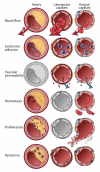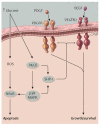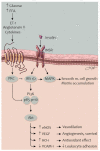Vascular complications of diabetes: mechanisms of injury and protective factors
- PMID: 23312281
- PMCID: PMC3546345
- DOI: 10.1016/j.cmet.2012.11.012
Vascular complications of diabetes: mechanisms of injury and protective factors
Abstract
In patients with diabetes, atherosclerosis is the main reason for impaired life expectancy, and diabetic nephropathy and retinopathy are the largest contributors to end-stage renal disease and blindness, respectively. An improved therapeutic approach to combat diabetic vascular complications might include blocking mechanisms of injury as well as promoting protective or regenerating factors, for example by enhancing the action of insulin-regulated genes in endothelial cells, promoting gene programs leading to induction of antioxidant or anti-inflammatory factors, or improving the sensitivity to vascular cell survival factors. Such strategies could help prevent complications despite suboptimal metabolic control.
Copyright © 2013 Elsevier Inc. All rights reserved.
Figures





References
-
- Aicher A, Heeschen C, Mildner-Rihm C, Urbich C, Ihling C, Technau-Ihling K, Zeiher AM, Dimmeler S. Essential role of endothelial nitric oxide synthase for mobilization of stem and progenitor cells. Nat Med. 2003;9:1370–6. - PubMed
-
- Aiello LP, Bursell SE, Clermont A, Duh E, Ishii H, Takagi C, Mori F, Ciulla TA, Ways K, Jirousek M, Smith LE, King GL. Vascular endothelial growth factor-induced retinal permeability is mediated by protein kinase C in vivo and suppressed by an orally effective beta-isoform-selective inhibitor. Diabetes. 1997;46:1473–80. - PubMed
-
- Aiello LP, Vignati L, Sheetz MJ, Zhi X, Girach A, Davis MD, Wolka AM, Shahri N, Milton RC. Oral protein kinase C beta inhibition using ruboxistaurin: efficacy, safety, and causes of vision loss among 813 patients (1,392 eyes) with diabetic retinopathy in the Protein Kinase C beta Inhibitor-Diabetic Retinopathy Study and the Protein Kinase C beta Inhibitor-Diabetic Retinopathy Study 2. Retina. 2011;31:2084–94. - PubMed
-
- Antonetti DA, Klein R, Gardner TW. Diabetic retinopathy. N Engl J Med. 2012;366:1227–39. - PubMed
Publication types
MeSH terms
Substances
Grants and funding
LinkOut - more resources
Full Text Sources
Other Literature Sources
Medical
Molecular Biology Databases

